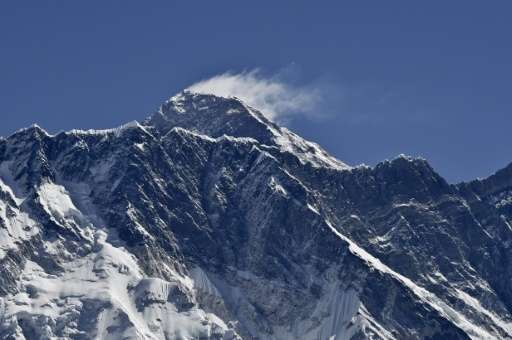Nepal seeks to drain giant glacial lake near Everest

Nepali soldiers have kicked off efforts to partially drain a giant glacial lake near Mount Everest, fearing possible flooding that could threaten the lives of thousands, an army official said Friday.
Scientists say climate change is causing Himalayan glaciers to melt at an alarming rate, creating huge glacial lakes which could burst their banks and devastate mountain communities.
Imja Tsho, located at an altitude of 5,010 metres (16,437 feet), just 10 kilometres (six miles) south of the world's highest peak, is the fastest-growing glacial lake in Nepal.
The surface area covered by the lake expanded from 0.4 to 1.01 square kilometres between 1984 and 2009, triggering concerns that it may breach its banks and flood villages downstream.
"With the aim of minimising the risk of a possible outburst... the Nepal Army has begun efforts to lower the level of water in Imja lake by opening a channel," said army spokesman, Tara Bahadur Karki.
"A mechanical gate will be installed and will be manually operated to control the water flow through the channel," Karki told AFP.
The work began in April and the army expects to complete the project by the end of the year, he said.
A flood would have a catastrophic impact on the lives of more than 56,000 people living in villages located as far away as Nepal's densely populated Terai plains, one scientist said.
"Dozens of villages located nearby and in the downstream Terai districts up to 50 kilometres away from the lake are vulnerable," Rishi Ram Sharma, Director General at the national Department of Hydrology and Meteorology told AFP.
"The lake had been gaining in volume over the last 30 to 40 years due to climate change."
Nepal is home to some 3,000 glacial lakes, of which seven are regarded as high-risk, Sharma said.
The move to partially drain the lake comes one year after a major international study warned that glaciers in the Everest region could shrink by 70 percent or disappear entirely by the end of the century, owing to climate change.
A study published in 2014 by the Kathmandu-based International Centre for Integrated Mountain Development used satellite imagery to show how Nepal's glaciers had shrunk by nearly a quarter between 1977 and 2010.
© 2016 AFP



















